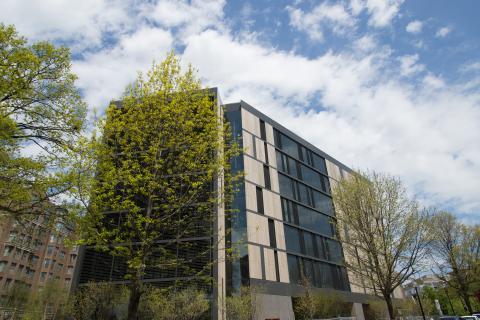950 New Hampshire Avenue
The building at 950 New Hampshire Avenue, NW is the primary building for Milken Institute SPH. Opened in the spring of 2014, it houses all of the school's academic departments and is used for classes and events. The building provides a variety of spaces for use by the students, faculty and staff of Milken Institute SPH.
Read the press release on the building opening
View videos of the new building
View/download photos of the building
Building Hours
For the safety and security of the Milken Institute SPH building's occupants and visitors, the building is restricted to SPH staff and faculty and those taking classes in the building. Faculty and staff who work at 950 New Hampshire Avenue have 24/7 access to the building and their office suites with their GWorld card. Students can only access the building when a security guard is staffing the front desk during the following times:
Monday through Friday: 7 AM to 10 PM
Saturday & Sunday: 7 AM to 3 PM
Please note, the Milken Institute SPH building follows the university holiday schedule, and is closed when the university is closed. View a list of university-observed holidays.
The building is a hub for faculty, students and staff to exchange ideas and foster dialogue around key public health issues. The ground floor includes a 227 seat auditorium as well as a separate "Convening Center" that allows the school to host a variety of conferences and academic events. Additional meeting space throughout the building provide excellent options for events that bridge academic study with the practice of public health.
Offices
The building contains the majority of offices for faculty, and all faculty offices have standing desks to promote a healthier workplace. Each desk is easily adjusted in seconds to either standing or sitting positions, creating a dynamic workplace that can be changed throughout the day. All staff also have the option of electing to use a standing desk model, allowing everyone working in the new building to enjoy the health benefits of standing.
Lab Space
The terrace (B1) level of the building houses six academic laboratories for the Department of Exercise and Nutrition Sciences. Additionally, the department offers fee-based research and public testing services for GW and the greater Washington DC metro region through the Metabolism & Exercise Testing (MET) Laboratory Service Core located on the same level.
The laboratory facilities offer state-of-the-art exercise and clinical equipment for metabolic, body composition, and human performance testing and academic training. An unparalleled student hands-on experience is facilitated across multiple core curriculum courses as students prepare for careers in exercise physiology, nutrition, public health, medicine, clinical and allied health, physical therapy, athletic training, and sports performance. The integration of laboratory and classroom spaces within the same facility helps professors transform their course material into creative learning scenarios that provide students with opportunities to participate in practical experiences related to their fields of study. The MET Lab Service Core serves to cultivate health-related research in physical activity, exercise physiology, nutrition, and human performance by providing a readily accessible and professional space for principal investigators to engage in rigorous and reliable data collection.
Classrooms
Fourteen classrooms and two lecture halls make this building a true center for academic activity. All academic spaces are outfitted with some of the most advanced audio-visual equipment at GW, and many spaces feature moveable furniture to create a flexible classroom where professors and students can customize the environment that best facilitates learning.
Sustainability
The building has earned a platinum rating under the Leadership in Energy and Environmental Design (LEED) Green Building Rating System of the US Green Building Council (USGBC). Sustainable features in the building include a rain-water collection system, terracotta panels, an HVAC system with chilled beam and mass air displacement technologies, an enhanced storm water management system to reduce storm water runoff by more than 25%, a green floor, low-flow plumbing fixtures, energy-saving lighting controls, and numerous local, rapidly renewable, and recycled content materials.
Study Space
The building’s approximate 115,000 square feet of gross floor area contain academic, administrative, and meeting uses as well as spaces for student meetings, study, and collaboration in seven above-grade and two below-grade stories. The building includes activity and breakout areas designed to accommodate both undergraduate and graduate students.


